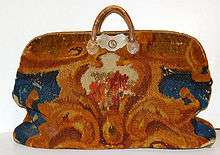Carpet bag
A carpet bag is a top-opening travelling bag made of carpet, commonly from an oriental rug. It was a popular form of luggage in the United States and Europe in the 19th century, featuring simple handles and only an upper frame, which served as its closure. Some small modern versions are used as handbags or purses.

History
The carpet bag was invented as a type of inexpensive personal baggage light enough for a passenger to carry, like a duffel bag, as opposed to a large rigid wooden or metal trunk, which required the assistance of porters. In 1886, the Scientific American described it as old-fashioned and reliable, "still unsurpassed by any, where rough wear is the principal thing to be studied. Such a bag, if constructed of good Brussels carpeting and unquestionable workmanship, will last a lifetime, provided always that a substantial frame is used."[1] Its use implied self-sufficiency: in Jules Verne's 1873 novel Around the World in Eighty Days, Phileas Fogg and Passepartout bring only a carpet bag as luggage, which holds a few items of clothing and a great deal of cash.
Carpet bags used to be made of Oriental rugs or the Brussels carpet referred to above, with "a heavy pile formed by uncut loops of wool on a linen warp".[2] Carpet was the chosen material because "remainder" pieces were easily bought for its manufacture.
Some carpet bags could also serve as a "railway rug", a common item in the 19th century for warmth in drafty, unheated rail-cars. The rug could either be opened as a blanket, or latched up on the sides as a travelling bag. From Robert Louis Stevenson's Travels with a Donkey in the Cévennes (1879): "... my railway-rug, which, being also in the form of a bag, made me a double castle for cold nights."[3]
Carpetbags made something of a brief resurgence in the 1960s with the emergence of the Hippie generation, salvaged from old family attics and second-hand stores. This gave rise to limited new manufacture as a trendy fashion accessory.[4]
Cultural impact
The carpetbaggers of the Reconstruction Era following the American Civil War—Northerners who moved to the South for economic or political opportunity—were given their name from often carrying only this type of luggage, implying they came with little while hoping to acquire lots.
The fictional nanny Mary Poppins arrived clutching her magical carpetbag.
The Magic Bag of Tricks in the Felix the Cat cartoons resembles a carpetbag.
Chapter Two of Herman Melville's Moby Dick is called The Carpet-Bag.
References
| Look up carpetbag in Wiktionary, the free dictionary. |
- Scientific American Supplement, No. 561, 2 October 1886 ebook: John T. Humphrey "Useful Bags and How to Make Them" Pg. 49
- "Brussels carpet definition and meaning | Collins English Dictionary". www.collinsdictionary.com. Retrieved 10 May 2019.
- Robert Luis Stevens, "Travels with a Donkey in the Cévennes" (1879)
- The Salt Lake Tribune, "Jerry Terrence brings back his popular bags from the '60s for a new generation" (13 February 2006)
External links
